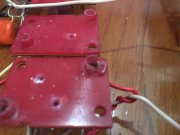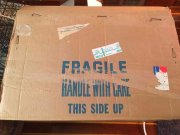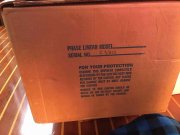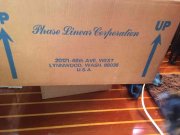That one socket looks pretty roached Mark. PL used those cheap Keystone sockets that easily break and crush, should have gone more upscale than those. Most of the back walls I have removed have had one or more broken barrels.
Joe,
Regarding TO-3 style sockets which were used in Phase Linear 400's and 700 series amplifiers:
The first generation of sockets Phase Linear had square corners were made by (United International Dynamics Corp) UID Electronics division of AMF (UID part number PTS-10E).
UID had a number of locations during their history that I am aware of:
Boston, MA
243 Lexinton
Waltham, MA
2029 Taft St.
Hollywood, FL
4105 Pembroke Rd
Hollywood, FL 33021
and
777 Westchester Ave.
White Plains, N.Y.
According to the USPTO listing utilizing the UID logo (that you see used on the transistor sockets and slide-switches): The first use in commerce was November 1967. The filing date was April 24, 1968. The registration date was July 8, 1969. The "Live/Dead Indicator": shows this as "DEAD". NOTE: UID was in business a number of years previous to 1967.
William Gluck was a chief engineer and "mgr electrical componets".
Larry N. McLenagan was president of UID for 8 years.
NOTE: UID Electronics also made "normal/direct coupled" switches used on 700B and 700 series two amplifiers.
https://worldwide.espacenet.com/pub...T=D&ND=3&date=19720704&DB=EPODOC&locale=en_EP
The second generation of sockets Phase Linear used had round corners and were made by Electronic Essentials Inc (EEI) (EEI part number 1004-5A)
EEI was located in Woodside NY 55982 and then 60-20 34th Ave Woodside, NY 11377-2212
According to an old USPTO (US Patent and Trademark Office listing) their products were first used in commerce Feb 14, 1971. The filing date Nov 8, 1978. The registration date was June 24, 1980. The "Live/Dead Indicator": shows this as "DEAD". The cancellation date was Nov 21, 1986.
The Keystone part number is 4618. All of the ones I have purchased from them have had the EEI logo on them. My guess is that Keystone either bought the remaining inventory or the equipment to fabricate them.
All of the sockets noted above were designed with a thread for a #6-20 screw. If my memory serves me correct, Dean told me that the torque spec was something like 7 in. lbs. but the employees were told to torque to 12 in. lbs. This caused many of the sockets hole diameters to enlarge when over-torqued. When they became enlarged they would use a #7 screw. NOTE: I also doubt that the employees used any torque screwdrivers. More than likely they were using their "acquired feel".
When I first met Dean and was repairing amplifiers he use to double-check all my torque on the TO-3 socket screws. Eventually he was pleased with my "acquired feel" and stopped checking. Perhaps I should acquire a dial torque wrench so I can measure the break-away torque (as measured CCW) after torquing some screws both by hand and using a torque screwdriver (set to 7 and 12 in lbs). Then I should be able to correlate the results.
A #6-20 screw has a major diameter (as measured over the crest of the threads) with a min of approx .135" and a max of .139" (nominal .138")
A #7 screw has a major diameter nominal dimension of .151". This becomes an issue as the I.D. of the boss (a.k.a barrel) (I recently checked on a new Keystone 4618) is approximately .140".
There are many cases of amplifiers that were built whereby Phase Linear used #7 screws exclusively. In those cases, many of the barrels are broken. In which case the build is good for only one use at best because when you go to repair the amp the socket will more than likely need to be replaced.
Unfortunately, some of the employees at Phase Linear were not very careful in ensuring that the socket "boss" got seated properly into the heat-sinks which caused some to be squashed. This squashing could have been eliminated by using one hand on the socket inside the chassis (ensuring proper alignment) and the other hand while torquing the screw. Usually I do this by first aligning and tightening the top and bottom sockets in the vertical bank of sockets.
When I repair a Phase Linear amplifier, I remove all the heat-sinks. This allows me to lift up the output stage and inspect several things which include the emitter resistors for bulges and cracks as well as the transistors sockets for breaks, cracks or a squashed "boss".
After examining the sockets, I also reform the contacts and clean and lubricate them. Subsequently I have had no further issues.
My favorite screws Phase Linear used were the #6 slotted screws used on early 400 and 700 series 1 amplifiers. For some reason they didn't create the same issues as the hex head screws did.
Ed





